An AB Courtyard bench is a way to add beautiful accents and seating to any landscape. You can build it on an existing surface like a patio or pavement, as well as on soil. In this example we will create a bench that is 5 blocks high, with a seating height of 18 in. (460 mm).
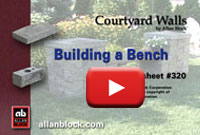
Video: How to Build a Garden Bench
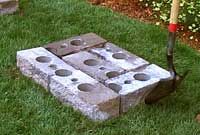
Mark the Location
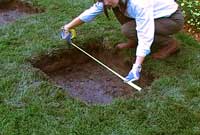
Build the Foundation
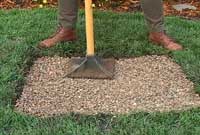
Fill Foundation Pad
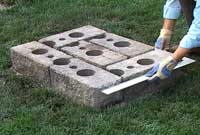
Build the First Post/Pillar
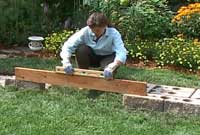
Build the Second Post/Pillar
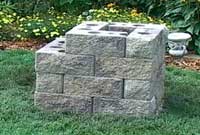
Build Additional Courses
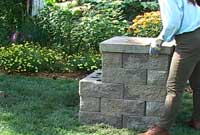
Cap the Posts
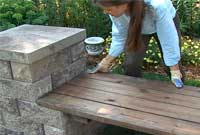
Build the Seat
Materials Needed
- 52 Corner Blocks*
- 4 Post Caps
- Flexible Concrete Adhesive
- 8 50 lbs bags (23 kg) of base rock (if building on soil)
- 1 Seating material 30 in. wide (760 mm) by the span of the posts/pillars.
- 2 - Cedar Studs - 2 in. x 4 in. x 22 in. (approx.) (50 mm x 100 mm x 560 mm)
- 4 - Cedar Planks - 1 in. x 6 in. x 73 in. (approx.) (25 mm x 150 mm x 1.9 m)
* Note: For a post/pillar that is 6 blocks tall with a 24 in. (600 mm) seating height, you will need 64 Corner Blocks.
Tools Needed
- Square
- Measuring Tape
- Shovel
- Level
- A 2 x 4 for Leveling
- Work Gloves
Step 1: Layout
Determine the location of the 2 posts/pillars and lay the first course of block to establish where to dig the foundation pad using the pattern layout shown below. Make sure the posts/pillars are directly across from each other and are appropriately spaced to accommodate your desired seating material. If building on an existing surface, skip ahead to Step 4.
Step 2: Build the Foundation
Mark the location of the posts/pillars with a shovel, remove the blocks and dig a 24 in. (600 mm) wide, 30 in. (760 mm) long and 4 in. (100 mm) deep hole.
Step 3: Fill Foundation Pad
Using a hand tamper, compact the bottom of the hole, then place 4 in. (100 mm) of base rock in the hole and compact again. Check for level.
*NOTE: The soil beneath the foundation pad must be a good quality compactable material. If soft soils are encountered, they will need to be removed and replaced with additional base rock. A good foundation will ensure a stable post/pillar for years to come.
Base Rock: Using the proper materials to create the base foundation for the panels is important when building on soil. We recommend using a compactible base rock material that is gravel in varying sizes of angular or smooth aggregates similar to the wall rock used in retaining walls or a road/ paver base type material.
Step 4: Build the First Post/Pillar
Install the base course of the first post/pillar using 6 Corner Blocks on the base rock foundation, or on the existing surface, using the pattern for Course 1 shown below. Square up the blocks, tamp into place and level. If building on an existing surface, shims can be used to help level the blocks.
Step 5: Build the Second Post/Pillar
Install the first Corner Block of the 2nd post/pillar. Use a level and a 2x4 to span across to ensure that the Corner Block of the 2nd post/pillar will be level with the 1st post/pillar. This will ensure the seating area will be level. Make adjustments as needed by adding or removing the base rock or installing shims if building on an existing surface. Install remaining blocks to complete the first course, check again for level with the 1st post/pillar.
Step 6: Continue Building
With both posts/pillars level, continue stacking 2 more courses, alternating between the patterns shown to offset the seams from the course below. Do not stack the blocks up using only one pattern (seams should not create a straight line the full height of the post/pillar).
On the 4th course, change the pattern to create the area for the seating material to rest. Only 4 corner blocks will be needed for the next 2 courses and all blocks will be installed with their long sides facing out.
Step 7: Finish the Posts
Finish each post/pillar with two Post Caps. Secure them in place with a bead of masonry adhesive along the outside edge of Corner Blocks. Then set the Post Caps in place.
Step 8: Construct the Seat
Measure and install the seating material. Cedar deck boards or a slab of natural stone make good seating materials. See your local supplier for more options.